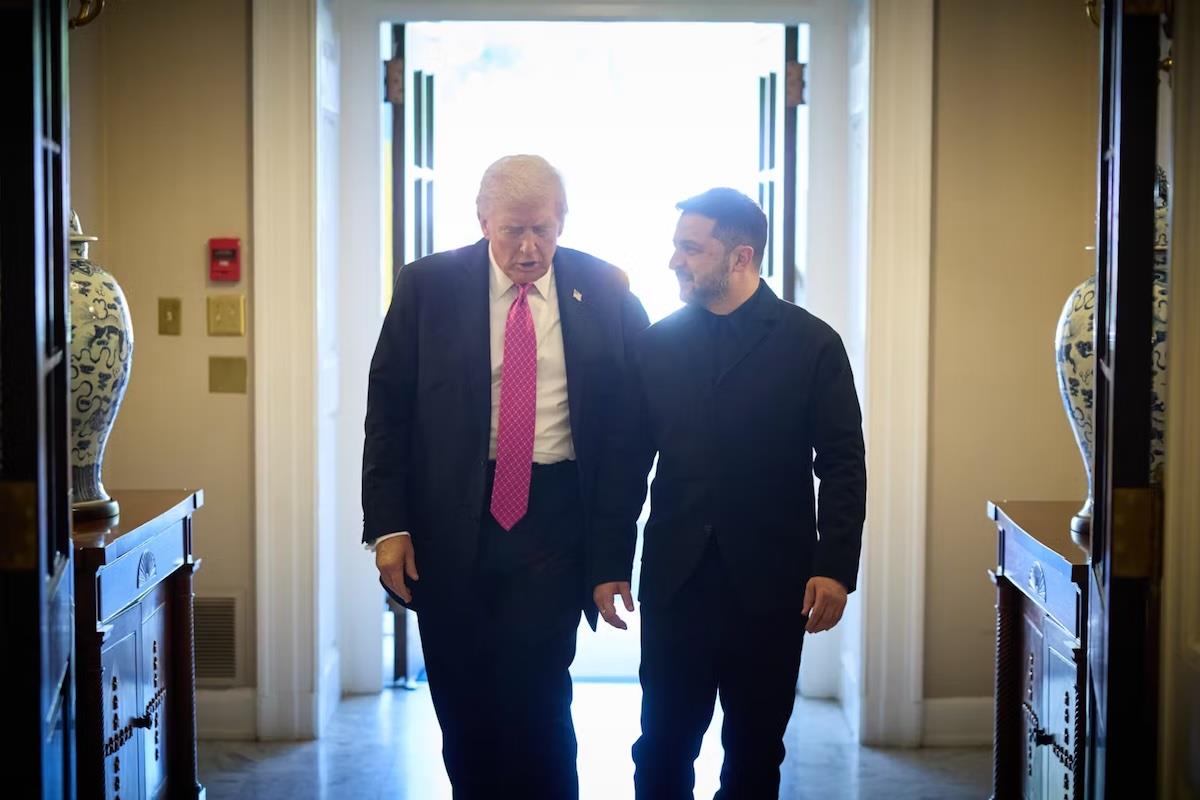
Zelensky Running Out Of Time With Trump Peace Plan On The Table
There is little likelihood that Ukrainian President Volodymyr Zelensky will accept the plan as it is, but he may offer various amendments to sow confusion and force delays. The US has threatened to pull all its support from Ukraine if it disagrees, though Trump said Saturday the framework was not necessarily his final offer to Ukraine.
The Russians initially said they never saw the 21-point plan. Now Moscow is saying they have the text of the plan and find it a good basis for concluding what Russia terms the Special Military Operation (SMO).

Putin meets with the command post of the Russian forces“West” grouping
It is impossible to say whether anything will actually result from the Trump plan.
A key question is why the administration decided to push the plan, especially since an earlier version, which emerged from the Trump-Putin Summit in Alaska, only lasted one day after Trump returned to Washington and met with Zelensky. Why try again?
It is not hard to see a possible motive for the administration's urgent action now. The military situation is deteriorating fast in Ukraine and Russian President Vladimir Putin, wearing a military uniform, held a meeting in Donbas with his military leadership, where he optimistically stated that Russia was going to fulfill all the objectives of the SMO.
“We have our own tasks, our own goals. The main one is the unconditional achievement of the goals of the special military operation,” Putin said while calling the Ukrainian authorities an organized criminal group.
Latest stories
China-backed Whoosh rail locks Indonesia in a financial bind

Breaking down the leaked Russia-Ukraine peace framework
Some serious problems are emerging in Ukraine, including a cascading and dangerous corruption scandal that threatens Zelensky's credibility as Ukraine's leader, a growing realization in Europe that there is hardly any money to keep underwriting Ukraine, and the exposure of a Ukrainian plot in Poland of a false flag operation, deeply embarrassing Poland's Prime Minister Donald Tusk.
There is already political dissidence in Kiev, something that until now has mostly been suppressed under martial law conditions. But more serious are Ukrainian operations in Europe that started with the realization that the Nordstream pipeline had been destroyed (at least in part) by Ukrainian special operators.
Poland refused a German court request to extradite one of the alleged Ukrainian saboteurs, but Italy's Court of Cassation has now approved the extradition of another Ukrainian for the same crime. This means some sort of trial will take place in Germany, and Poland's questionable denial of extradition (”He was a hero” said Tusk) looks like what it was attempting, that is to say, a cover-up.
The latest embarrassment was over the partially successful sabotage of a rail line in Poland. The explosion was on the track between Warsaw and Lublin to the south-east. Tusk said the route was“crucially important for delivering aid to Ukraine.”
The spokesman for the Polish Coordinator of Special Services, Jacek Dobrzynski, has stated that“everything indicates” Russian intelligence services carried out or ordered the rail line attack. Tusk, pointing at Russia, called it an“an unprecedented act of sabotage.”
The Polish prime minister said a military-grade C4 explosive device detonated on Saturday (November 22) near the village of Mika
It is noteworthy that the actual damages to the railroad were minimal and symbolic. But the Poles wanted to make it seem consequential and Russia's doing.
The trouble for Tusk and others in the Polish special services is that the fellows they caught and arrested were Ukrainian, not Russian. To cover up his mistake, Tusk tried to argue, without a scintilla of evidence, that the Ukrainians were working for the Russians.
What is emerging is that Kyiv has been trying to provoke Europe into sending troops to Ukraine. Many of the still-unexplained alleged drone attacks in western and eastern Europe probably originate with Ukraine, not Russia (as they are too far away for Russian drones).
Attempts were made to claim drones were sent by Russian ships, but even after stopping and inspecting a suspect vessel, nothing was found. That has not stopped a flow of propaganda all over the media.
The Trump administration has been energetically gathering intelligence, some of it to target Russian assets (including on Russian territory), but some of it to assess the war itself. Whatever they have so far concluded is not public.
What we do have are reports from observers, including military men in Russia and Ukraine, who are all saying more or less the same thing: that Ukraine is running out of men, material and time and continually losing territory, with key defense bastions like Pokrovsk soon to fall completely to the Russians.
Similarly, Russia has made dramatic advances in Zaphorize in the south and has taken Kupyansk, although Ukraine denies the Russian claim. Kupyansk is in the north of the eastern Kharkiv region. That region includes Kharkiv itself, which is Ukraine's second-largest city.

Sign up for one of our free newsletters
-
The Daily Report
Start your day right with Asia Times' top stories
AT Weekly Report
A weekly roundup of Asia Times' most-read stories
The administration must also worry that a Ukrainian collapse would foster upheavals in Europe, threatening NATO's credibility as a defense alliance. For the last year or more, there has been a growing challenge to Europe's leadership class, reaching as far south as Romania and as far north as the UK.
If Ukraine collapses, it is very likely that critical NATO-supporting governments in France, Germany, UK and Romania will change hands with new governments seeking to reconcile with the Russians. The EU itself, already divided, may lose its grip.
Trump administration officials are well aware of the dynamics of the political and military situation in Ukraine and Europe. The US-EU-sponsored attempt to overthrow the Putin government has proven so far a complete failure.
It was an enterprise that never had much of a chance, especially when Russia unleashed its FSB on so-called private voluntary organizations operating inside Russia and shut down Alexei Navalny's organization, putting him in prison, where he died under mysterious circumstances.
With the entire Ukrainian enterprise wobbly, Zelensky will likely make every effort he can to block the US 21-point plan. How the Trump administration will respond is anyone's guess.
Stephen Bryen, a former US deputy under secretary of defense, is a special Asia Times correspondent. This article, originally published on his Substack newsletter Weapons and Strategy, is republished with permission.
Sign up here to comment on Asia Times stories Or Sign in to an existing accounThank you for registering!
An account was already registered with this email. Please check your inbox for an authentication link.
-
Click to share on X (Opens in new window)
Click to share on LinkedIn (Opens in new window)
LinkedI
Click to share on Facebook (Opens in new window)
Faceboo
Click to share on WhatsApp (Opens in new window)
WhatsAp
Click to share on Reddit (Opens in new window)
Reddi
Click to email a link to a friend (Opens in new window)
Emai
Click to print (Opens in new window)
Prin

Legal Disclaimer:
MENAFN provides the
information “as is” without warranty of any kind. We do not accept
any responsibility or liability for the accuracy, content, images,
videos, licenses, completeness, legality, or reliability of the information
contained in this article. If you have any complaints or copyright
issues related to this article, kindly contact the provider above.

















Comments
No comment